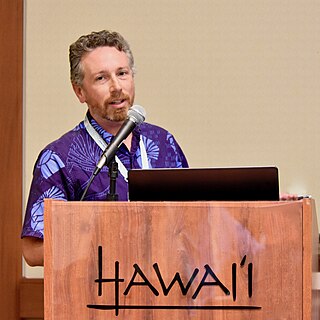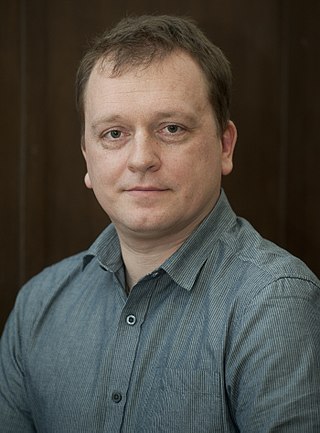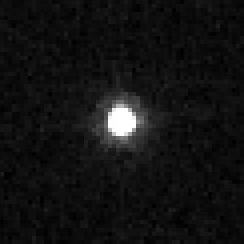Related Research Articles
Brett James Gladman is a Canadian astronomer and a full professor at the University of British Columbia's Department of Physics and Astronomy in Vancouver, British Columbia. He holds the Canada Research Chair in planetary astronomy. He does both theoretical work and observational optical astronomy.
Devana, Zevana, less often Zievonia is the goddess of wild nature, forests, hunting and the moon worshiped by the Western Slavs. In the sources, she was first mentioned in the 15th century by Jan Długosz, who compared her to the Roman goddess Diana. Dziewanna is also a Polish name for Verbascum, and the etymology of the word is unclear. After strong criticism from Aleksander Brückner, researchers rejected her authenticity, but nowadays it is accepted by an increasing number of researchers. Sometimes, in folk rituals, she performs together with Morana.

Aleksander Wolszczan is a Polish astronomer. He is the co-discoverer of the first confirmed extrasolar planets and pulsar planets. He is a graduate of the Nicolaus Copernicus University in Toruń and works as a professor at the Pennsylvania State University.

Bohdan Paczyński or Bohdan Paczynski was a Polish astronomer notable for his theories and work in the fields of stellar evolution, accretion discs, and gamma ray bursts. He is the recipient of the Eddington Medal (1987), the Henry Draper Medal (1997), the Gold Medal of the Royal Astronomical Society (1999), and the Order of Polonia Restituta (2007).

Chadwick A. Trujillo is an American astronomer, discoverer of minor planets and the co-discoverer of Eris, the most massive dwarf planet known in the Solar System.

Stardome Observatory & Planetarium is a public astronomical observatory and planetarium situated in Maungakiekie/One Tree Hill Domain in Auckland, New Zealand.
Scott Sander Sheppard is an American astronomer and a discoverer of numerous moons, comets and minor planets in the outer Solar System.
Tadeusz Julian Banachiewicz was a Polish astronomer, mathematician and geodesist.

OGLE-TR-122 is a binary stellar system containing one of the smallest main-sequence stars whose radius has been measured. It was discovered when the Optical Gravitational Lensing Experiment (OGLE) survey observed the smaller star eclipsing the larger primary. The orbital period is approximately 7.3 days. The system's primary is thought to resemble the Sun.

Highland Road Park Observatory or Baton Rouge Observatory is an astronomical observatory jointly operated by Louisiana State University's astronomy department, Baton Rouge Astronomical Society, and The Recreation & Park Commission for the Parish of East Baton Rouge. It is in Baton Rouge, in the U.S. state of Louisiana, in Highland Road Park.

Krisztián Sárneczky is a Hungarian teacher of geography and prolific discoverer of minor planets and supernovae, researching at Konkoly Observatory in Budapest, Hungary. He is a board member of the Hungarian Astronomical Association (HAA) and member of the American Association of Variable Star Observers, leader of the Comet Section of the HAA, and is a contributor in the editorial work of Hungarian Astronomical Almanach.

OGLE-2005-BLG-390Lb is a super-Earth ice exoplanet orbiting OGLE-2005-BLG-390L, a star 21,500 ± 3,300 light-years from Earth near the center of the Milky Way, making it one of the most distant planets known. On January 25, 2006, Probing Lensing Anomalies NETwork/Robotic Telescope Network (PLANET/Robonet), Optical Gravitational Lensing Experiment (OGLE), and Microlensing Observations in Astrophysics (MOA) made a joint announcement of the discovery. The planet does not appear to meet conditions presumed necessary to support life.

The Optical Gravitational Lensing Experiment (OGLE) is a Polish astronomical project based at the University of Warsaw that runs a long-term variability sky survey (1992–present). The main goals are the detection and classification of variable stars, discovery of microlensing events, dwarf novae, and studies of the structure of the Galaxy and the Magellanic Clouds. Since the project began in 1992, it has discovered a multitude of extrasolar planets, together with the first planet discovered using the transit method (OGLE-TR-56b) and gravitational microlensing. The project has been led by professor Andrzej Udalski since its inception.
OGLE-TR-123 is a binary stellar system containing one of the smallest main-sequence stars whose radius has been measured. It was discovered when the Optical Gravitational Lensing Experiment (OGLE) survey observed the smaller star eclipsing the larger primary. The orbital period is approximately 1.80 days.

471143 Dziewanna (provisional designation 2010 EK139) is a trans-Neptunian object in the scattered disc, orbiting the Sun in the outermost region of the Solar System.
Andrzej Jarosław Udalski is a Polish astronomer and astrophysicist, and director of the Astronomical Observatory of the University of Warsaw. He is also head of the Department of Observational Astrophysics at Astronomical Observatory, the head and project manager of the Optical Gravitational Lensing Experiment, and editor of the quarterly journal Acta Astronomica.

Megan E. Schwamb is an American astronomer and planetary scientist, and lecturer at Queen's University, Belfast. Schwamb has discovered and co-discovered several trans-Neptunian objects, and is involved with Citizen science projects such as Planet Four and Planet Hunters.
A Blue large-amplitude pulsator (BLAP) is a proposed class of pulsating variable star. They are extremely rare, with only 14 being known after examining around a billion stars from the Optical Gravitational Lensing Experiment (OGLE) survey.
References
- ↑ "471143 Dziewanna (2010 EK139)". Minor Planet Center. Retrieved 7 October 2018.